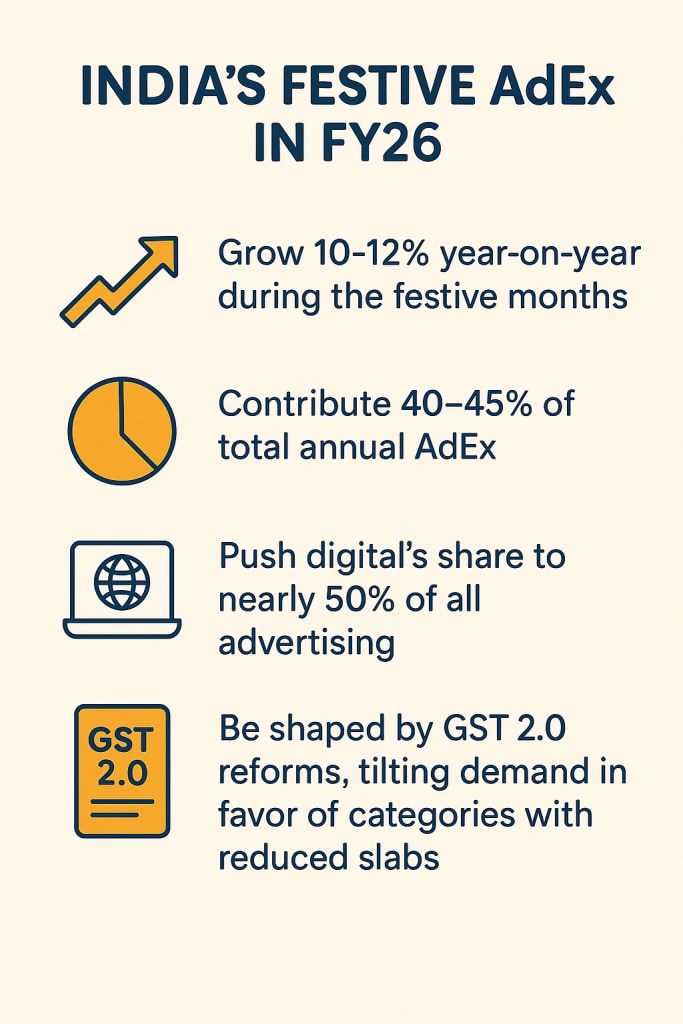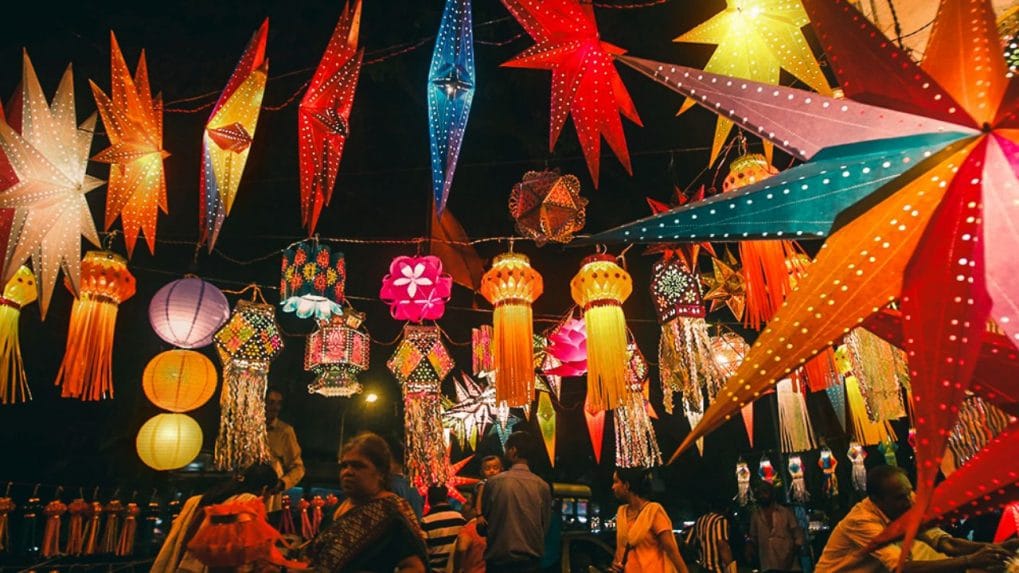GST 2.0 likely to lift festive cheer: India’s AdEx set to top Rs 55,000 cr in FY26, up 18–20% YoY
Digital-first campaigns, rural demand, and revised GST slabs are shaping the most competitive festive advertising season in India’s history
ADVERTISEMENT
As the festive season approaches, India’s advertising industry is gearing up for one of its biggest years yet, with brands across sectors unleashing record spends to capture consumer attention. From Diwali shopping to the wedding rush, ad budgets are swelling, powered not only by optimism in consumer demand but also by the impending impact of GST 2.0 reforms, which could tilt spending strategies across categories.
Ananay Jain, Partner and National Media Industry Leader, Grant Thornton Bharat forecast that festive campaigns are expected to contribute around 28–30% of India’s total advertising spend in FY26, estimated at Rs 25,000– Rs 27,000 crore, up from approximately 26% last year.
This increase reflects a 7–8% growth over FY25, driven by larger budgets, creative campaigns, and a strong focus on digital-first strategies.
Why Festive AdEx is Surging
The reasons for the advertising surge are both economic and cultural.
According to Sandeep Ranade, Executive Vice President and Head of Quantitative Research Division at Hansa Research, “The festive season (August to December) accounts for 30–50% of annual advertising expenditure as the contribution varies by categories." He estimates a marginal 1–1.5% uptick compared to the last year’s festive period.
The reasons for this increase are: expected increase in spending from tier 2 and 3 towns plus rural areas (with a good monsoon expectation this year, higher government spending in rural areas, e-commerce reach in smaller towns and rural areas), improved consumer confidence, more money in consumers’ hands due to change in income tax slabs, and quick-commerce plus e-commerce push in urban areas.

Ranade’s view reflects a broader confidence among advertisers. With rural demand expected to outpace urban growth, especially in FMCG, and with discretionary income on the rise, festive sentiment is translating into bigger budgets.
Imtiyaz Vilatra, CEO, Posterscope India, put it bluntly. “The overall advertising expenditure (AdEx) during this festive season is expected to grow by 10–12% year-over-year, with the festive period accounting for around 40% of total annual spends observed every year.
Read more: Rural demand and early bookings to fuel up to 30% surge in festive OOH adex
Despite challenges like inflation and a shorter festive window, brands continue to prioritize this period for impactful visibility, making it a crucial time for ad investments.”
Who Will Spend the Most?
Categories expected to dominate this festive season include FMCG, consumer durables, e-commerce, jewelry, auto, and fashion.
“The August to December period also has a marriage season (mostly November–December, post Diwali) in addition to the festivals,” said Ranade.
“Categories like jewelry, FMCG, consumer durables and electronics, fashion and lifestyle, auto and e-commerce will dominate spending. In addition, electricals, paints, real estate, travel and tourism, retail etc. will also see an increase in advertising. FMCG brands will focus on packaged foods, confectioneries, beverages and personal care. BFSI too will see momentum through festive loans and cashback-led credit card promotions.”
Read more: India adex to rise 8.4% to $21.3 billion in 2025, even as global growth slows to 6%: WPP Media
Parab echoed this. “Largely e-commerce platforms, FMCG brands, and consumer electronics/consumer durables are expected to lead the charge. Beyond these core spenders, we’re seeing strong momentum from automobiles, especially compact SUVs, EVs, and two-wheelers driven by attractive trade-in offers and festival financing schemes.”
Deleise Ross, SVP & Head of Business, Mudramax, added that traditional festive categories are also innovating to stay relevant.
“Consumer electronics, consumer durables, and e-commerce typically allocate substantial resources to festive campaigns. E-commerce platforms create buzz by organizing prominent sales events, while jewelry and apparel are stepping up their game with innovative and culturally relevant marketing campaigns.”
Media Mix: Digital at the Helm
If festive advertising is growing, digital is the medium powering it.
Ross projected that digital advertising will account for nearly 50% of total AdEx this year, driven by OTT and Connected TV (CTV) platforms.
“Platforms such as CTV and OTT services are experiencing remarkable expansion, driven by the increasing preference for streaming content and the flexibility these platforms offer. Simultaneously, traditional television advertising continues to rise in prominence during peak festive periods, while print, though smaller, still plays a vital role through innovative formats and large-format ads.”
Parab pointed out that festive spends are tilting further toward digital-first strategies: “40–45% of total AdEx is expected during the festive season of FY26, compared to 35–38% last year. Brands are clearly planning to spend more, with digital and out-of-home driving sharper targeting.”
GST 2.0: The Wild Card
While optimism drives record spending, GST 2.0 reforms could reshape strategies sector by sector.
Currently, advertising services attract 18% GST. Sectors like FMCG, auto, and e-commerce face little impact since input tax credit (ITC) is fully claimable. But in industries where ITC is restricted, real estate, healthcare, and education, advertising becomes a direct cost.
For smaller businesses and regional advertisers, paying GST upfront creates working capital strain.
Read more: Rajeev Chandrasekhar hails Modi’s next-gen GST reforms as ‘pivotal moment’ for New India
“Predictable and simplified GST rates allow brands to plan larger, more targeted campaigns,” said Jain. “But higher GST on non-essential or luxury items can temper ad spend, especially in fashion, luxury, and durable categories.”
For advertisers, that could unlock a new wave of category demand, shifting ad budgets further toward appliances and durables.
In the words of Parab, “The festive months are becoming the most important time of the year for advertisers to grab people’s attention and drive sales.”
But as Jain cautions, GST could remain a leveler, “While digital-first campaigns, rural demand, and aspiration will fuel growth, tax reforms will continue to determine how budgets are allocated.”

